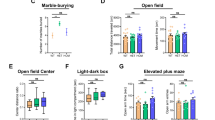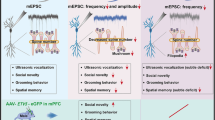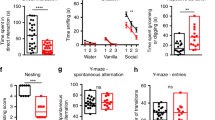Abstract
Autism spectrum disorder (ASD) is a group of conditions characterized by impaired social interaction and communication, and restricted and repetitive behaviours. ASD is a highly heritable disorder involving various genetic determinants1. Shank2 (also known as ProSAP1) is a multi-domain scaffolding protein and signalling adaptor enriched at excitatory neuronal synapses2,3,4, and mutations in the human SHANK2 gene have recently been associated with ASD and intellectual disablility5. Although ASD-associated genes are being increasingly identified and studied using various approaches, including mouse genetics6,7,8,9,10,11,12,13,14,15,16, further efforts are required to delineate important causal mechanisms with the potential for therapeutic application. Here we show that Shank2-mutant (Shank2−/−) mice carrying a mutation identical to the ASD-associated microdeletion in the human SHANK2 gene exhibit ASD-like behaviours including reduced social interaction, reduced social communication by ultrasonic vocalizations, and repetitive jumping. These mice show a marked decrease in NMDA (N-methyl-d-aspartate) glutamate receptor (NMDAR) function. Direct stimulation of NMDARs with d-cycloserine, a partial agonist of NMDARs, normalizes NMDAR function and improves social interaction in Shank2−/− mice. Furthermore, treatment of Shank2−/− mice with a positive allosteric modulator of metabotropic glutamate receptor 5 (mGluR5), which enhances NMDAR function via mGluR5 activation17, also normalizes NMDAR function and markedly enhances social interaction. These results suggest that reduced NMDAR function may contribute to the development of ASD-like phenotypes in Shank2−/− mice, and mGluR modulation of NMDARs offers a potential strategy to treat ASD.
This is a preview of subscription content, access via your institution
Access options
Subscribe to this journal
Receive 51 print issues and online access
$199.00 per year
only $3.90 per issue
Buy this article
- Purchase on Springer Link
- Instant access to full article PDF
Prices may be subject to local taxes which are calculated during checkout




Similar content being viewed by others
References
Pinto, D. et al. Functional impact of global rare copy number variation in autism spectrum disorders. Nature 466, 368–372 (2010)
Sheng, M. & Kim, E. The shank family of scaffold proteins. J. Cell Sci. 113, 1851–1856 (2000)
Boeckers, T. M., Bockmann, J., Kreutz, M. R. & Gundelfinger, E. D. ProSAP/Shank proteins—a family of higher order organizing molecules of the postsynaptic density with an emerging role in human neurological disease. J. Neurochem. 81, 903–910 (2002)
Ehlers, M. D. Synapse structure: glutamate receptors connected by the shanks. Curr. Biol. 9, R848–R850 (1999)
Berkel, S. et al. Mutations in the SHANK2 synaptic scaffolding gene in autism spectrum disorder and mental retardation. Nature Genet. 42, 489–491 (2010)
Ehninger, D. & Silva, A. J. Rapamycin for treating tuberous sclerosis and autism spectrum disorders. Trends Mol. Med. 17, 78–87 (2011)
Ramocki, M. B. & Zoghbi, H. Y. Failure of neuronal homeostasis results in common neuropsychiatric phenotypes. Nature 455, 912–918 (2008)
Jamain, S. et al. Reduced social interaction and ultrasonic communication in a mouse model of monogenic heritable autism. Proc. Natl Acad. Sci. USA 105, 1710–1715 (2008)
Tabuchi, K. et al. A neuroligin-3 mutation implicated in autism increases inhibitory synaptic transmission in mice. Science 318, 71–76 (2007)
Bozdagi, O. et al. Haploinsufficiency of the autism-associated Shank3 gene leads to deficits in synaptic function, social interaction, and social communication. Mol. Autism 1, 15 (2010)
Peça, J. et al. Shank3 mutant mice display autistic-like behaviours and striatal dysfunction. Nature 472, 437–442 (2011)
Bangash, M. A. et al. Enhanced polyubiquitination of Shank3 and NMDA receptor in a mouse model of autism. Cell 145, 758–772 (2011)
Wang, X. et al. Synaptic dysfunction and abnormal behaviors in mice lacking major isoforms of Shank3. Hum. Mol. Genet. 20, 3093–3108 (2011)
Silverman, J. L. et al. Sociability and motor functions in Shank1 mutant mice. Brain Res. 1380, 120–137 (2011)
Südhof, T. C. Neuroligins and neurexins link synaptic function to cognitive disease. Nature 455, 903–911 (2008)
Berkel, S. et al. Inherited and de novo SHANK2 variants associated with autism spectrum disorder impair neuronal morphogenesis and physiology. Hum. Mol. Genet. 21, 344–357 (2012)
Gregory, K. J., Dong, E. N., Meiler, J. & Conn, P. J. Allosteric modulation of metabotropic glutamate receptors: structural insights and therapeutic potential. Neuropharmacology 60, 66–81 (2011)
Leblond, C. S. et al. Genetic and functional analyses of SHANK2 mutations suggest a multiple hit model of autism spectrum disorders. PLoS Genet. 8, e1002521 (2012)
Hayashi, M. K. et al. The postsynaptic density proteins Homer and Shank form a polymeric network structure. Cell 137, 159–171 (2009)
Oliet, S. H., Malenka, R. C. & Nicoll, R. A. Two distinct forms of long-term depression coexist in CA1 hippocampal pyramidal cells. Neuron 18, 969–982 (1997)
Zhu, J. J., Qin, Y., Zhao, M., Van Aelst, L. & Malinow, R. Ras and Rap control AMPA receptor trafficking during synaptic plasticity. Cell 110, 443–455 (2002)
Shepherd, J. D. & Huganir, R. L. The cell biology of synaptic plasticity: AMPA receptor trafficking. Annu. Rev. Cell Dev. Biol. 23, 613–643 (2007)
Blundell, J. et al. Neuroligin-1 deletion results in impaired spatial memory and increased repetitive behavior. J. Neurosci. 30, 2115–2129 (2010)
Uslaner, J. M. et al. Dose-dependent effect of CDPPB, the mGluR5 positive allosteric modulator, on recognition memory is associated with GluR1 and CREB phosphorylation in the prefrontal cortex and hippocampus. Neuropharmacology 57, 531–538 (2009)
Verpelli, C. et al. Importance of Shank3 protein in regulating metabotropic glutamate receptor 5 (mGluR5) expression and signaling at synapses. J. Biol. Chem. 286, 34839–34850 (2011)
Kinney, G. G. et al. A novel selective positive allosteric modulator of metabotropic glutamate receptor subtype 5 has in vivo activity and antipsychotic-like effects in rat behavioral models. J. Pharmacol. Exp. Ther. 313, 199–206 (2005)
Ayala, J. E. et al. mGluR5 positive allosteric modulators facilitate both hippocampal LTP and LTD and enhance spatial learning. Neuropsychopharmacology 34, 2057–2071 (2009)
Auerbach, B. D., Osterweil, E. K. & Bear, M. F. Mutations causing syndromic autism define an axis of synaptic pathophysiology. Nature 480, 63–68 (2011)
Darrah, J. M., Stefani, M. R. & Moghaddam, B. Interaction of N-methyl-d-aspartate and group 5 metabotropic glutamate receptors on behavioral flexibility using a novel operant set-shift paradigm. Behav. Pharmacol. 19, 225–234 (2008)
Schmeisser, M. J. et al. Autistic-like behaviours and hyperactivity in mice lacking ProSAP1/Shank2. Nature http://dx.doi.org/10.1038/nature11015 (29 April 2012)
Acknowledgements
We would like to thank Macrogen for assistance in the production of mice. This work was supported by the National Creative Research Initiative Program, WCU program (R31-2008-000-10071-0), and Institute for Basic Science (to E.K.), the National Research Foundation of Korea (to M.G.L.; grant 2012-0000812), the National Creative Research Initiative Program & WCU program (to B.-K.K.; 2007-0054846), the Basic Science Research Program through the National Research Foundation of Korea (to K.L. and Y.C.B.; 2011-0028240), and the National Leading Research Laboratory Program (to D.K.; 2011-0028772). H.-R.L. and J.-I.K. are supported by the BK21 fellowship, and H.W. is supported by the TJ Park Doctoral Fellowship and National Junior Research Fellowship.
Author information
Authors and Affiliations
Contributions
H.-R.L., J.-I.K. and B.-K.K. performed and analysed all the electrophysiological experiments and data; H.Y.G., E.S.J. and J.-S.L. generated and characterized Shank2−/− mice; S.-G.P. performed USV experiments; H.W., W.M. and J.L. performed immunoblot analysis; H.W., W.M., S.H. and C.C. contributed to mouse breeding and behavioural characterization; Y.S.C. performed electron microscopy experiments; H.W. and W.M. conducted all the other experiments; K.L., D.K., Y.C.B., B.-K.K., M.G.L. and E.K. supervised the project and wrote the manuscript. B.-K.K., M.G.L. and E.K. contributed equally to this work.
Corresponding authors
Ethics declarations
Competing interests
The authors declare no competing financial interests.
Supplementary information
Supplementary Information
This file contains Supplementary Figures 1-21 and Supplementary Methods with additional references. (PDF 17263 kb)
Supplementary Table 1
This table contains the information on the number, gender and age of animals used in the experiments associated with this paper. (XLS 45 kb)
Supplementary Table 2
This table contains the statistical results of the experiments associated with this paper. (XLS 118 kb)
Supplementary Movie 1
This movie shows a pup retrieval assay with a wild-type mouse. (MOV 12752 kb)
Supplementary Movie 2
This movie shows a pup retrieval assay with a Shank2−/− mouse. (MOV 25132 kb)
Supplementary Movie 3
This movie shows an example of repetitive jumping mixed with upright scrabbling in a Shank2−/− mouse. (MOV 1584 kb)
Supplementary Movie 4
This movie shows an example of repetitive grooming in a Shank2−/− mouse. (MOV 1103 kb)
Supplementary Movie 5
This movie shows an example of repetitive digging in a Shank2−/− mouse. (MOV 1975 kb)
Rights and permissions
About this article
Cite this article
Won, H., Lee, HR., Gee, H. et al. Autistic-like social behaviour in Shank2-mutant mice improved by restoring NMDA receptor function. Nature 486, 261–265 (2012). https://doi.org/10.1038/nature11208
Received:
Accepted:
Published:
Issue Date:
DOI: https://doi.org/10.1038/nature11208
This article is cited by
-
Crucial role of TFAP2B in the nervous system for regulating NREM sleep
Molecular Brain (2024)
-
Increased social interaction in Shank2-deficient mice following acute social isolation
Molecular Brain (2023)
-
Expression profiles of the autism-related SHANK proteins in the human brain
BMC Biology (2023)
-
Shank2 identifies a subset of glycinergic neurons involved in altered nociception in an autism model
Molecular Autism (2023)
-
Downregulation of mGluR1-mediated signaling underlying autistic-like core symptoms in Shank1 P1812L-knock-in mice
Translational Psychiatry (2023)
Comments
By submitting a comment you agree to abide by our Terms and Community Guidelines. If you find something abusive or that does not comply with our terms or guidelines please flag it as inappropriate.



